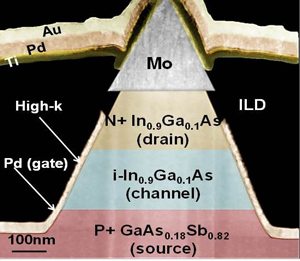- News
16 December 2013
Low-power tunneling transistor for high-speed implantable devices at low voltage
At the IEEE International Electron Devices Meeting (IEDM 2013) in Washington DC (9-11 December), epiwafer foundry and substrate maker IQE plc of Cardiff, Wales, UK, Pennsylavania State University and the US Commerce Department’s National Institute of Standards and Technology (NIST) presented a joint paper on a new type of transistor that aims to make possible fast and low-power computing devices for energy-constrained applications such as smart sensor networks, implantable medical electronics and ultra-mobile computing. The new near-broken-gap tunnel field-effect transistor (NBTFET) device uses the quantum mechanical tunneling of electrons through an ultrathin energy barrier to provide high current at low voltage. Specifically, NBTFETs with a 200nm channel length that exhibited record drive current (ION) of 740μA/μm, intrinsic RF transconductance (GM) of 700μS/μm and a cut-off frequency (fT) of 19GHz at a source-drain voltage (VDS) of 0.5V.
Tunnel field-effect transistors are considered to be a potential replacement for existing CMOS transistors, as device makers search for a way to continue shrinking the size of transistors and packing more transistors into a given area. The main challenge facing current chip technology is that as size decreases, the power required to operate transistors does not decrease in step. The results can be seen in batteries that drain faster and in increasing heat dissipation that can damage delicate electronic circuits. Various new types of transistor architecture using materials other than the standard silicon are being studied to overcome the power consumption challenge.
“This transistor has previously been developed in our lab to replace MOSFET transistors for logic applications and to address power issues,” says lead author and Penn State graduate student Bijesh Rajamohanan. “In this work we went a step beyond and showed the capability of operating at high frequency, which is handy for applications where power concerns are critical, such as processing and transmitting information from devices implanted inside the human body.”
 Picture: Transmission electron microscope cross-section of the vertical TFET. Interface of the source and channel is the point where electron tunneling occurs. ILD is the interlayer dielectric separating the contacts. Top plane contacts are gold (Au), palladium (Pd) and molybdenum (Mo). Image: Suman Datta/Penn State.
Picture: Transmission electron microscope cross-section of the vertical TFET. Interface of the source and channel is the point where electron tunneling occurs. ILD is the interlayer dielectric separating the contacts. Top plane contacts are gold (Au), palladium (Pd) and molybdenum (Mo). Image: Suman Datta/Penn State.
For implanted devices, generating too much power and heat can damage the tissue that is being monitored, while draining the battery requires frequent replacement surgery. Led by professor of electrical engineering Suman Datta, the researchers tuned the material composition of the indium gallium arsenide (InGaAs)/gallium arsenide antimony (GaAsSb) so that the energy barrier was close to zero - or near broken gap, which allowed electrons to tunnel through the barrier when desired. To improve amplification, the researchers moved all the contacts to the same plane at the top surface of the vertical transistor.
 Picture:
A scanning electron microscope top view of the TFET. Image: Suman Datta/Penn State.
Picture:
A scanning electron microscope top view of the TFET. Image: Suman Datta/Penn State.
The device was developed as part of a larger program sponsored by the US National Science Foundation (NSF) through the Nanosystems Engineering Research Center for Advanced Self-Powered Systems of Integrated Sensors and Technologies (NERC-ASSIST). The broader goal of the ASSIST program is to develop battery-free, body-powered wearable health monitoring systems with Penn State, North Carolina State University (NCSU), University of Virginia, and Florida International University as participating institutions.
The paper ‘Demonstration of InGaAs/GaAsSb Near Broken-gap Tunnel FET with ION=740µA/µm, GM=700µS/µm and Gigahertz Switching Performance at VDS=0.5V’ will be available in the conference proceedings publication of the IEEE International Electron Devices Meeting (IEDM 2013) in Washington DC (9-11 December).


